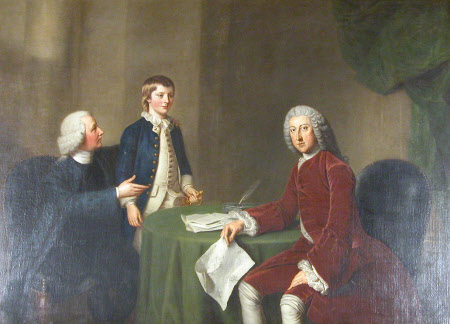Lord John Augustus Hervey (1757-1796), presented by his Father Frederick Augustus Hervey, 4th Earl of Bristol and Bishop of Derry (1730-1803) to William Pitt the elder, 1st Earl of Chatham (1708-1778)
William Hoare of Bath, RA (Eye 1707 – Bath 1792)
Category
Art / Oil paintings
Date
1771 (signed and dated)
Materials
Oil on canvas
Measurements
1676 x 2337 mm (66 x 92 in)
Place of origin
Bath
Order this imageCollection
Ickworth, Suffolk
NT 851732
Caption
In this unusual composition, the 4th Earl of Bristol, who was also the Bishop of Derry and is known as the 'Earl-Bishop', presents his son, John to William Pitt the elder, 1st Earl of Chatham. John is about to begin a naval career and is dressed as a midshipman in blue and gold. The underlying subject of the picture may be connected to Pitt's advocacy of the British navy and British military power during his political career. William Pitt the elder was elected as a Member of Parliament in 1735 and served as British Prime Minister from 1766-1768.
Summary
Oil painting on canvas, Lord John Augustus Hervey (1757-1796), presented by his father Frederick Augustus Hervey, 4th Earl of Bristol and Bishop of Derry (1730-1803) to William Pitt the elder, 1st Earl of Chatham (1708-1778) by William Hoare of Bath, RA (Eye 1707 – Bath 1792), signed, lower right: Wm Hoare / pt 1771. Three three-quarter-length portraits, the Earl-Bishop, seated at the left of a table, wearing dark clerical clothes and blue coat, presents his son, dressed as a midshipman in rich blue coat with gilt buttons, cream waistcoat with gilt buttons, matching breeches, holding sword hilt in his left hand, and with short light brown hair, to William Pitt, 1st Earl of Chatham, seated on the right dressed in deep red coat and breeches, white shirt with cravat and lace frill at wrists, long white stockings, who holds a plan of a fort on a river in his right hand, his right arm resting on a table covered with a green cloth; green draped curtain on right-hand side. The full novelty of this – it must be admitted, awkwardly composed – picture never seems to have been appreciated. Although Chatham was alive (but a good deal older) when it was painted, he is shown in another sphere from the Earl-Bishop and his son, almost like a divine apparition. What sources can the artist – and his patron – have been drawing on? In 1770 Chatham, a former Prime Minister, made a powerful speech insisting on the importance of British naval power. John Augustus was about to embark on a naval career and this picture seems to represent a kind of secular blessing by the object of his father’s admiration
Provenance
Evidently commissioned by the Earl-Bishop (1730-1830) and sent over to Downhill, with which left to his second cousin once removed, Sir Henry Hervey-Bruce, 1st Bt (d. 1822); thence by descent and inheritance, until auctioned as one of a group of Hervey-Bruce pictures described as ‘The Property of a Lady’[this was Margaret Florence Jackson, Mrs Morris (d. 1954), who had married as her first husband, in 1916, after the death of his first wife, Sir Hervey Ronald Bruce, 5th Bt (1872-1924); and in 1925, after his death, Lt -Colonel Charles Morris (d.1950), following whose death she would appear to have sold these Hervey-Bruce heirlooms rather than passing them on, or leaving them, to her son, the 6th Bt]; Christie’s, 16 June 1950, lot 149, bought by ‘Hervey’ for 52 gns. ‘Hervey’ will have been the 4th Marquess of Bristol (1863-1951), or his agent on whose death valued for probate; accepted in lieu of tax by HM Treasury, and transferred to the National Trust in 1956
Credit line
Ickworth, The Bristol Collection (acquired through the National Land Fund and transferred to The National Trust in 1956)
Makers and roles
William Hoare of Bath, RA (Eye 1707 – Bath 1792), artist


